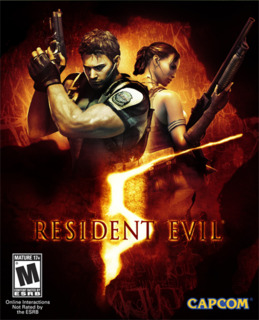Bigger, Better, more Bad-ass!
It is true however, that there was very little left in "Resident Evil 4" that could be associated with its predecessors. Adventure motifs were all but absent, save for the occasional "fetch" puzzle, and horror codes such as frights or psychological mind-games were completely missing. What wasn't lacking however, was a creepy atmosphere and a tension oriented game-play that effectively forced players to feel the stress of encountering the dangers of a massive zombie attack. The biggest difference in "5" is that it lacks the quality aesthetic work that made its predecessor's atmosphere so foreboding, and focuses solely on the empowering of stressful encounters with enemies. Keeping in tradition with an Americanized view on entertainment, the first way of enhancing the sense of stress and dread that the new "Resident Evil" feeds on is by upping the scale. On one hand, by using bigger monsters and boss-fights, by delivering larger set-pieces and backgrounds for game-play, and by increasing the sheer numbers of enemies that the player has to get rid of to finish the game. A fair estimate would be that there are more zombies in "Resi 5" than in the rest of the series all together. The other change in scale comes from one of the game's most important design decisions: the co-op mode.
Though "Resident Evil" always had more than one main protagonist to its stories, only the fifth iteration allows players to play side by side with a friend. It's immediately obvious when you pick up the controller and start playing, that the game was designed and tested to fit into co-op play. Level design, inventory management, boss battles and even the rare puzzles all need a form of cooperative effort to overcome difficulties. This cooperative dynamic allows co-op play to be engaging, by making communication a valid asset for the development of mutual strategies, thus increasing the liberty players have to tackle each scenario and each encounter. The downside is that the game is so focused on co-op, that the single player mode becomes irrelevant and almost unplayable. There's a good AI controlled companion there to assist you, but it's severely limited in the ways in which it can communicate and interact with the player, making complex strategies nigh impossible. And since the game makes its greatest asset that dual player logic, this transforms the single player mode into an empty chore, filled with constant struggles to make the virtual companion take the proper actions in order to pass each of the game's challenges.
Truth be said, co-op makes for an exciting way of playing, and makes the game shine as a pure action game, like few have been able to in the recent past. However, that isn't, nor ever was, the core of the "Resident Evil" experience. This misunderstanding of the series' legacy, and its core design, becomes fully apparent in the nature of the final levels of the game, in which it takes a form that seems straight out of "Tomb Raider" - a large, eerie tomb from an ancient civilization filled with small puzzles - or "Gears of War" - a military base populated with fully armed zombies, wrapped around a cover-oriented level design scheme. And these are only the worst examples of the loss of identity on part of this "Resident Evil", because even the when the game behaves similarly to "4" it misses out on important notions of aesthetic that were integrate part of the series - by using serious voice acting for a cheesy storyline, or daylight flooded African shanty towns as a scenario for a horror tale.
Every design choice in "Resident Evil 5" screams of an attempt at capturing American FPS audiences, from the embodiment of action-oriented staples such as co-op play, a cover-based battle system and epic-sized set-pieces, to the more buffed-up character designs and supposedly more serious narrative. Trampled beneath these realizations is the past of "Resident Evil", completely forgotten by the game's designers. Instead of trying to re-frame the action oriented nature of "4" in a an action-adventure context, closer to the series' classic ideas, "Resident Evil 5" designers chose to upgrade "Resident Evil 4" by taking inspiration from mainstream shooters. Had it been a thoughtful reinterpretation of Capcom's most beloved series, then it might have been a unique game to explore, but as it stands, it's as "unique" as the latest entry of "Killzone", "Call of Duty" or "Gears of War". "Resident Evil 5" may be "bigger, better, more bad-ass", but there's already too much of that around nowadays.

